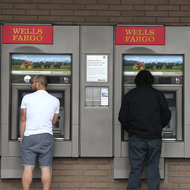8:46 a.m. | Updated
Wells Fargo on Friday reported $5.1 billion in profit for the fourth quarter, a 24 percent increase, driven by the bank’s lucrative mortgage business.
Seizing on low-interest rates that have spurred a flurry of refinancing activity, the San Francisco-based bank again notched record profits. For the last 12 quarters, profits at the bank have increased.
In this latest quarter, Wells Fargo reported earnings of 91 cents a share, which exceeded analysts’ expectations. Ahead of the report, analysts polled by Thomson Reuters estimated that the bank would report earnings of 89 a share.
Wells Fargo, unlike many of its rivals, has been able to steadily increase its revenue. Launching bank earnings season, Wells Fargo reported $21.95 billion in revenue in the fourth quarter, up 7 percent from a year earlier.
Much of the revenue gains stemmed from the bank’s consumer lending business, as borrowers jumped on record low interest rates to refinance their mortgages. Wells Fargo, which dominates the market as the nation’s largest mortgage lender, notched $125 billion in mortgage originations, up from $120 billion in the fourth quarter of 2011. Refinancing applications accounted for nearly 75 percent of that total.
The big profits in the group came from the extra money that Wells Fargo makes bundling the mortgages into bonds and selling them to the government. In the fourth quarter, the bank reported $2.8 billion of so-called net gains on its mortgages activities, up 51 percent from the previous year.
Under the tenure of its chief executive, John Stumpf, Wells Fargo has aggressively expanded into the mortgage market, a strategy that might help the bank surpass its rivals in profits, notably JPMorgan Chase.
Wells Fargo’s net interest margin, a closely watched profits metric that measures the difference between the interest the bank collects and the interest it pays on its own borrowings, was down slightly to 3.56 percent, from 3.89 percent a year earlier.
Profits in the community banking division, which spans Wells Fargo’s retail branches and mortgage business, increased 14 percent to $2.9 billion.
The bank successfully courted more cash from depositors, adding $72 billion in total core checking and savings deposits than a year earlier.
“The company’s underlying results were driven by solid loan growth, improved credit quality, and continued success in improving efficiency,” Wells Fargo’s chief financial officer, Tim Sloan, said in a statement.
The bank has benefited from sweeping federal stimulus initiatives that have buoyed the mortgage business. The Treasury Department has helped prompt Americans to refinance their mortgages.
Wells Fargo is the reigning titan in the mortgage industry, generating roughly a third of all the mortgages across America. Mortgage originations continued to climb, up 4 percent to $125 billion.
Adding to its mortgage-related profits, Wells Fargo reported a $926 million profit from its servicing business, in which the bank collects payments from homeowners. That’s up roughly 6 percent from a year earlier.
Alongside the consumer loan business, Wells Fargo had gains in its wealth management business, a particular focus for the bank to defray the impact of federal regulations that dragged down profits elsewhere.
Still, Wells Fargo could see its profits from residential mortgages wane later this year if the Federal Reserve halts its extensive bond buying spree.
Working to move beyond the mortgage crisis woes that have dogged the bank, Wells Fargo has been brokering deals with federal regulators. Wells Fargo was one of 10 banks that this week signed onto an $8.5 billion settlement with the Comptroller of the Currency and the Federal Reserve over claims that shoddy foreclosure practices may have led to the wrongful eviction of homeowners.
The sweeping federal pact ends a deeply flawed review of millions of loans in foreclosure that was mandated by federal regulators in 2011. The review, which was ended this week, began in November 2011 amid mounting public fury that bank employees were churning through hundreds of foreclosure filings without reviewing them for accuracy.
In addition to the settlement, the bank set aside $1.2 billion to prevent foreclosures.
Article source: http://dealbook.nytimes.com/2013/01/11/wells-fargo-profit-jumps-24-percent-in-fourth-quarter-driven-by-mortgages/?partner=rss&emc=rss



